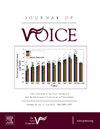眼动追踪技术对柔性喉镜下声带麻痹的视觉解释
IF 2.4
4区 医学
Q1 AUDIOLOGY & SPEECH-LANGUAGE PATHOLOGY
引用次数: 0
摘要
目的喉镜解释是耳鼻喉科的一项重要诊断技能。然而,在评估柔性喉镜视频时使用的具体视觉策略的理解有限。眼球追踪技术允许在动态任务中客观地研究眼球运动。本研究的目的是探讨从新手到专家的临床经验,在喉镜解释单侧声带麻痹(UVFP)时的视觉凝视策略。方法对30例患者播放5段柔性喉镜检查视频,每段视频长10秒。在观看完每个视频后,参与者报告了他们对“左声带麻痹”、“右声带麻痹”或“没有声带麻痹”的印象。收集眼动追踪数据并分析选定感兴趣区域(AOI)的注视持续时间和注视次数。诊断的准确性和视觉凝视模式在新手,有经验的,和专家组之间进行比较。结果新手组的诊断正确率显著低于经验组(P = 0.04)。所有组在观看双侧声带活动正常的视频时都表现出相似的视觉凝视模式,花最大比例的时间观看气管。在观看左、右VFP录像时,各组间存在差异,但气管始终是固定时间最长、固定次数最多的前3位结构。结论眼动追踪是喉镜解释的一种新工具。随着进一步的研究,它有可能对耳鼻喉学学习者的培训有用,以提高诊断技能。本文章由计算机程序翻译,如有差异,请以英文原文为准。
Visual Interpretation of Vocal Fold Paralysis in Flexible Laryngoscopy Using Eye Tracking Technology
Objectives
Interpretation of laryngoscopy is an important diagnostic skill in otolaryngology. There is, however, limited understanding of the specific visual strategies used while assessing flexible laryngoscopy video. Eye-tracking technology allows for objective study of eye movements during dynamic tasks. The purpose of the present study was to explore visual gaze strategies during laryngoscopy interpretation of unilateral vocal fold paralysis (UVFP) across clinician experience from novice to expert.
Methods
Thirty individuals were shown five flexible laryngoscopy videos, each 10 seconds long. After viewing each video, participants reported their impressions of “left vocal fold paralysis,” “right vocal fold paralysis,” or “no vocal fold paralysis.” Eye tracking data were collected and analyzed for duration of fixation and number of fixations on select areas of interest (AOI). Diagnostic accuracy and visual gaze patterns were compared between novice, experienced, and expert groups.
Results
Diagnostic accuracy among learners in the novice group was significantly lower than those in the more experienced groups (P = 0.04). All groups demonstrated similar visual gaze patterns when viewing the video with normal bilateral vocal fold mobility, spending the greatest percentage of time viewing the trachea. There were differences among groups when viewing the videos of left or right VFP, but the trachea was always in the top three structures for greatest fixation duration and highest number of fixations.
Conclusions
Eye-tracking is a novel tool in the setting of laryngoscopy interpretation. With further study it has the potential to be useful for the training of otolaryngology learners to improve diagnostic skills.
求助全文
通过发布文献求助,成功后即可免费获取论文全文。
去求助
来源期刊

Journal of Voice
医学-耳鼻喉科学
CiteScore
4.00
自引率
13.60%
发文量
395
审稿时长
59 days
期刊介绍:
The Journal of Voice is widely regarded as the world''s premiere journal for voice medicine and research. This peer-reviewed publication is listed in Index Medicus and is indexed by the Institute for Scientific Information. The journal contains articles written by experts throughout the world on all topics in voice sciences, voice medicine and surgery, and speech-language pathologists'' management of voice-related problems. The journal includes clinical articles, clinical research, and laboratory research. Members of the Foundation receive the journal as a benefit of membership.
 求助内容:
求助内容: 应助结果提醒方式:
应助结果提醒方式:


